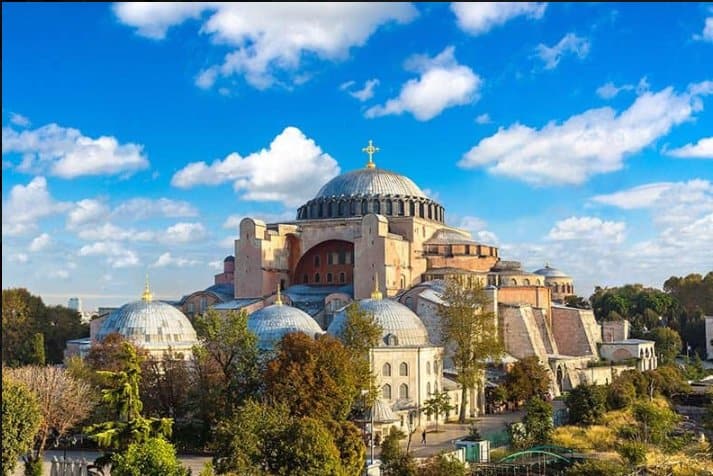The church of Hagia Sophia (literally “Holy Wisdom”) in Constantinople, now Istanbul, was first dedicated in 360 by Emperor Constantius, son of the city’s founder, Emperor Constantine.
Hagia Sophia served as the cathedra, or bishop’s seat, of the city. Originally called Megale Eklesia (Great Church), the name Hagia Sophia came into use around 430.
The beginnings
Emperor Justinian I inaugurated the Hagia Sophia on December 27, 537 AD. Sophia is the phonetic spelling in Latin of the Greek word for wisdom. The church was dedicated to the Wisdom of God, the Logos. The present building was the third church to occupy the site, as the earlier one was destroyed. Justinian commissioned Greek architects Isidore of Miletus and Anthemius of Tralles to build a new basilica. It was so richly and artistically decorated that Justinian proclaimed, “ Solomon, I have outdone thee!”
Initially called Magna Ecclesia meaning the Great Church because of its size, it had millions of golden glass cubes forming a glittering canopy overhead. Each cube was set at a subtly different angle to reflect the flicker of candles and oil lamps that illuminated night ceremonies. The sixth-century historian Procopius marvelled that the Byzantine Cathedral “does not appear to rest upon a solid foundation, but to cover the place beneath as though it were suspended from heaven by the fabled golden chain.”
The first church structure was destroyed during riots in 404; the second church, built and dedicated in 415 by Emperor Theodosius II, burned down during the Nika revolt of 532, which caused vast destruction and death throughout the city.
Immediately after the riots, Emperor Justinian I (r. 527–65) ordered the church rebuilt. The new building was inaugurated on December 27, 537. Architects Anthemios of Tralles and Isidoros of Miletos most likely were influenced by the mathematical theories of Archimedes (ca. 287–212 B.C.).
The vast, airy naos, or central basilica, with its technically complex system of vaults and semi-domes, culminates in a high central dome with a diameter of over 101 feet (31 meters) and a height of 160 feet (48.5 meters). This central dome was often interpreted by contemporary commentators as the dome of heaven itself. Its weight is carried by four great arches, which rest on a series of tympana and semi-domes, which in turn rest on smaller semi-domes and arcades. This complicated structural system was prone to problems: the first dome collapsed in 558, to be rebuilt in 562 to a greater height. Earthquakes and earth subsidence have also taken their toll on the building over the centuries, although the surviving main structure is essentially that which was first built between 532 and 537.
The interior of Hagia Sophia was paneled with costly colored marbles and ornamental stone inlays. Decorative marble columns were taken from ancient buildings and reused to support the interior arcades. Initially, the upper part of the building was minimally decorated in gold with a huge cross in a medallion at the summit of the dome. After the period of Iconoclasm (726–843), new figural mosaics were added, some of which have survived to the present day.
After Mehmet II’s conquest of the city in 1453, Hagia Sophia was converted to a mosque (Ayasofya Camii), which it remained until the fall of the Ottoman empire in the early twentieth century. A view of Hagia Sophia during the conquest is conveyed in a woodcut by Pieter Coecke van Aelst, depicting the procession of Süleyman the Magnificent through the Hippodrome. During this period, minarets were built around the perimeter of the building complex, Christian mosaic icons were covered with whitewash, and exterior buttresses were added for structural support. In 1934, the Turkish government secularized the building, converting it into a museum, and the original mosaics were restored.
The complex remained a mosque until 1931, when it was closed to the public for four years. It was re-opened in 1935 as a museum by the secular Republic of Turkey.[According to data released by the Ministry of Culture and Tourism, Hagia Sophia was Turkey's most visited tourist attraction in 2015 and 2019.
In early July 2020, the Council of State annulled the Cabinet's 1934 decision to establish the museum, revoking the monument's status, and a subsequent decree by Turkish president Recep Tayyip Erdoğan ordered the reclassification of Hagia Sophia as a mosque.
The 1934 decree was ruled to be unlawful under both Ottoman and Turkish law as Hagia Sophia's waqf, endowed by Sultan Mehmed, had designated the site a mosque; proponents of the decision argued the Hagia Sophia was the personal property of the sultan.
This redesignation is controversial, drawing condemnation from the Turkish opposition, UNESCO, the World Council of Churches, the International Association of Byzantine Studies, and many international leaders.

